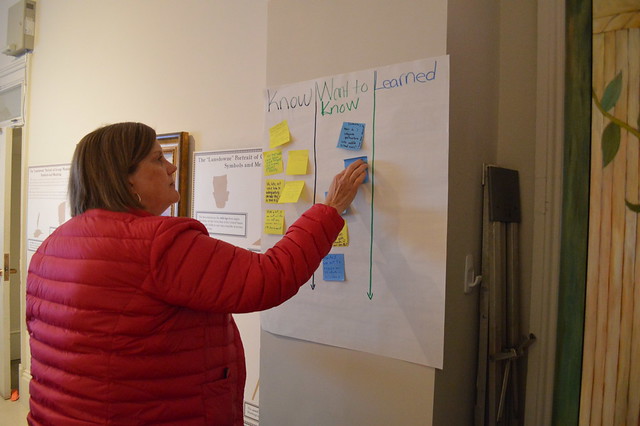The Sweat of Their Face: Portraying American Workers
On November 14, 2017, twenty-two educators gathered at the Smithsonian National Portrait Gallery to partake in a workshop on a new exhibition titled The Sweat of Their Face: Portraying American Workers. Student and Teacher Programs Manager, Briana Zavadil White and Faye Colon, Professional Development Coordinator at Teaching for Change, collaborated to provide educators with an interactive program.
Briana and Faye used a K (know) W (want to know) and L (learn) chart to thread together each component of the night's activities. As teachers entered the National Portrait Gallery (NPG) Education Center they were asked to write down what they knew about labor and labor history.
Curator of Painting and Sculpture, Dorothy Moss, provided teachers with a tour of the exhibition as she shared the history of many of the portraits. According to Moss, she and Senior Historian Emeritus David C. Ward selected portraits which highlighted workers who are too often forgotten and unknown but have played, and in some cases continue to play, an integral role in shaping America. Following the tour teachers were asked to write down any questions they had about the exhibition, the tour and or labor history in general which were then added to the KWL chart.
Afterwards they participated in The U.S. Labor Mixer, a Rethinking Schools lesson by Katy Swalwell, an assistant professor of education at Iowa State University. The lesson highlights events and individuals (real and imagined) in labor history who organized to fight for improved pay and working conditions. For the purposes of this workshop, only events related to the visual history represented in The Sweat of Their Face were selected and additional roles were added.
As an opening activity prior to The U.S. Labor Mixer, participants were given a portrait that was created during the time period and corresponded with the labor topic of their event. They explored the exhibition until they found their assigned portrait. Then they took notes on what they saw in the portrait, what they thought was happening or what they thought the portrait represented, and any questions they had about the portrait.
The teachers read about their respective historic event and stepped into their designated role. They walked around the exhibition and had a conversation with three other people. The objective was for participants to “interview” one another and share information about their labor event. The mixer provided participants the opportunity to learn about events in labor history in an engaging and interactive way.
Finally each teacher was given a post-it and was asked to write down one new thing they learned about labor history that was added to the KWL chart. In concentric circles, educators discussed what they had learned from the session.
Here is some of their feedback from the workshop:
I like that we got a “taste” of the student activity instead of spending a full 90 minutes acting as students.
I enjoyed the curator talk, what thoughts behind the exhibit were and what drove it. Also, the role play I think is a great tool to help kids relate to work and have another dimension added.
The see/think/wonder activities and the role play mixer were most effective because I became an active participant.
I loved the labor role play activity.
The mixer event was awesome – really encouraged us to make connections with the art.
I love how interactive these programs are and how it can connect so many classes.
I loved the role play activity. Was also impressed by the curator’s guide. It was a fantastic way of getting a brief overview of the entire exhibition while also diving into the complexities of the theme (institutionally as a museum but also historically).





